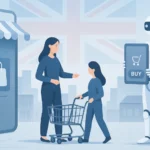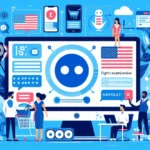✨ What is Generative AI?
Generative AI refers to a class of AI models designed to generate new and original content from learned data patterns. Unlike traditional AI—which focuses primarily on analyzing and recognizing existing information—generative models like GPT (Generative Pre-trained Transformer) and DALL·E create novel outputs, such as articles, social media posts, videos, images, and more.
These capabilities provide marketers with a powerful toolkit to produce content that is not only relevant but highly creative and scalable, disrupting the conventional content production pipeline.
How Generative AI is Revolutionizing Content Marketing
1. Accelerating Content Creation Cycles
- Crafting first drafts of articles, blog posts, and newsletters in minutes.
- Generating creative visual content, including infographics, banners, and video scripts.
- Exploring numerous content variations instantly for A/B testing.
2. Driving Hyper-Personalization
Modern consumers expect personalized experiences tailored to their unique needs and preferences. Generative AI leverages deep data insights to:
Produce targeted marketing messages tuned to demographics, behaviors, and interests.
Customize content recommendations on websites, emails, and apps.
Create dynamic content that adapts in real time to user interactions.
Such hyper-personalization leads to higher engagement rates, more meaningful customer interactions, and ultimately, stronger brand loyalty.
3. Enabling Smarter Content Optimization
- Analyze content performance and user sentiment.
- Generate optimized versions of content that better align with SEO guidelines and audience preferences.
- Predict trends and topics that will resonate with target audiences, guiding future content strategy.
The Role of Generative AI in Brand Growth
- Enhancing Customer Engagement: AI-powered chatbots and virtual assistants use generative models to provide conversational, context-aware support 24/7, improving customer satisfaction and retention.
- Boosting Marketing ROI: Automating repetitive content tasks and generating impactful campaigns allow brands to optimize budget allocation and generate better returns on marketing spend.
- Innovating Product Experiences: Brands can use generative AI to co-create with customers—for example, allowing users to customize products or marketing materials, thus deepening emotional bonds.
Real-World Applications: Success Stories
Several brands have already leveraged generative AI to propel their marketing and growth:
A global retail brand used AI to create thousands of personalized email campaigns, increasing click-through rates by over 20%.
An education technology company deployed AI-generated interactive lessons and assessments, boosting learner engagement and satisfaction dramatically.
A fashion label incorporated AI-created designs into their collections, tapping into rapid trend adaptations and enhancing customer appeal.
These examples highlight how generative AI is not just a tool but a strategic partner in brand evolution.
Challenges and Ethical Considerations in Using Generative AI
Despite its benefits, generative AI also raises important challenges that brands must navigate carefully:
Content Authenticity: Maintaining truthfulness and accuracy is vital to avoid misinformation and protect brand reputation.
Intellectual Property: Clarifying ownership and rights associated with AI-generated content is necessary to prevent legal disputes.
Bias and Fairness: AI models may inadvertently perpetuate biases unless trained and monitored with equity in mind.
Transparency: Communicating AI involvement in content creation fosters consumer trust and ethical marketing practices.
At Aigentora.ai, we prioritize responsible AI implementation, ensuring clients benefit from innovative AI without compromising integrity.
How Aigentora.ai Can Help You Unlock Generative AI for Your Brand
- Automate content creation for diverse platforms and formats.
- Deliver in-depth audience insights to fuel personalization.
- Enable continuous learning and adaptation through real-time analytics.
- Offer easy-to-use interfaces for marketers of all skill levels.
🧠 Frequently Asked Questions About Generative AI in Content Marketing and Brand Growth
Generative AI automates content creation, enabling marketers to scale blog posts, social media campaigns, and ads while maintaining consistency and creativity. It reduces manual effort and drives faster go-to-market strategies.
Yes. By providing personalized, data-driven content to target audiences, generative AI builds trust, increases engagement, and helps brands strengthen their positioning in competitive markets.
AI-generated content is SEO-friendly when used responsibly. With human editing, AI content can align with Google’s quality guidelines, offering keyword-rich, value-driven material that ranks well organically.
AI analyzes customer data such as behavior, preferences, and purchase history to deliver personalized messages across email, ads, and content—boosting engagement and conversions.
No. Generative AI is a powerful assistant, but human creativity, brand voice, and strategy remain irreplaceable. The best results come from collaboration between AI tools and content teams.
AI can create diverse formats including blogs, landing pages, product descriptions, social media content, ad copies, video scripts, and even personalized email campaigns.
AI provides real-time analytics and insights by analyzing customer data, market trends, and campaign performance, enabling marketers to make data-driven decisions and optimize ROI.
Yes. By automating repetitive content tasks and accelerating creative development, AI reduces dependency on large teams—leading to significant savings while maintaining quality output.
Small businesses can use affordable AI tools for blog generation, SEO optimization, automated customer emails, and social media management to scale faster with limited resources.
The future of generative AI in branding lies in hyper-personalized experiences, AI-driven storytelling, real-time multilingual content creation, and deeper customer engagement across omnichannel platforms.






